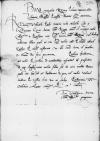Letter #3230
Bona Sforza to Ioannes DANTISCUSPiotrków, 1547-10-15
| received Heilsberg (Lidzbark Warmiński), 1547-11-06 Manuscript sources:
| ||||
Text & apparatus & commentaryPlain textText & commentaryText & apparatus
Reverendissimo in Christo Patri, domino
Reveren(de) or Reveren(disime)⌈Reveren(de)Reveren(de) or Reveren(disime)⌉ in Christo Pater sincere nobis dilecte.
Cum is generosus Czerni sacrae
Valeat tandem Paternitas Vestra bene diu ac felix.
Ex commissione sacrae maiestatis reginalis propria


 BCz, 3465, p. 352
BCz, 3465, p. 352